Income Tax Assignment - Analysis of Tax Residency and Deductions
VerifiedAdded on 2023/05/30
|7
|1996
|267
Homework Assignment
AI Summary
This assignment solution addresses several income tax scenarios. Question 1 focuses on determining Amity's tax residency for the year ending June 30, 2016, considering her employment in Australia, relocation to Kiribati, and relevant case law like F.C. of T. v. Applegate. Question 2 examines a barter transaction and the tax implications of a prize, referencing cases like F.C. of T. v. Cooke & Sherden and Scott v. Federal Commissioner of Taxation. Question 3 explores tax deductions related to loan interest for a property used for both residential and commercial purposes, and also for a business that has wound up, referencing Ronpibon Tin v FC of T. Finally, Question 4 analyses assessable income and deductible expenses for a business, calculating taxable income and tax payable, including franking credits. The solution utilizes relevant sections of ITAA 1936 and ITAA 1997, as well as various case laws to support its conclusions.
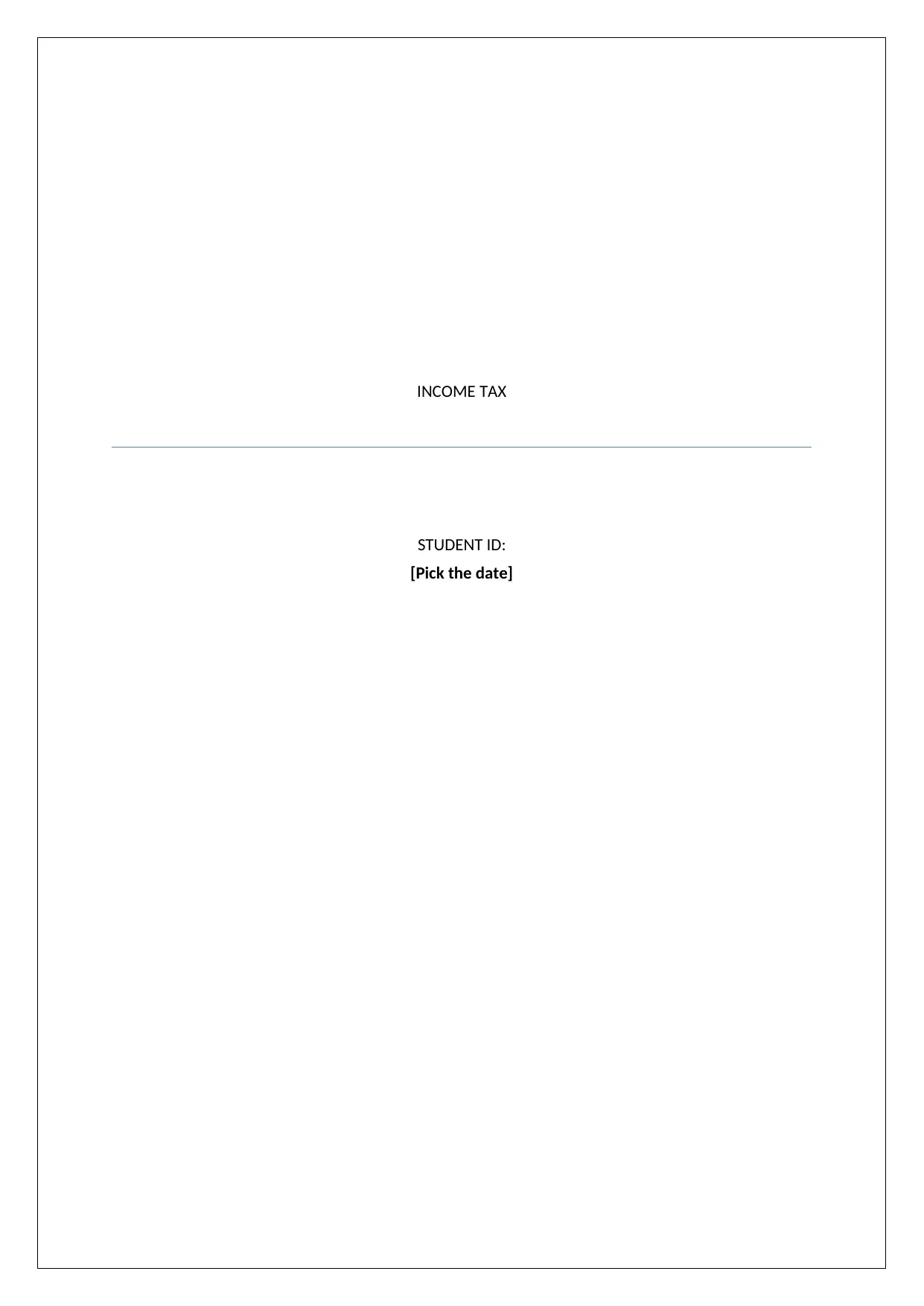
INCOME TAX
STUDENT ID:
[Pick the date]
STUDENT ID:
[Pick the date]
Paraphrase This Document
Need a fresh take? Get an instant paraphrase of this document with our AI Paraphraser
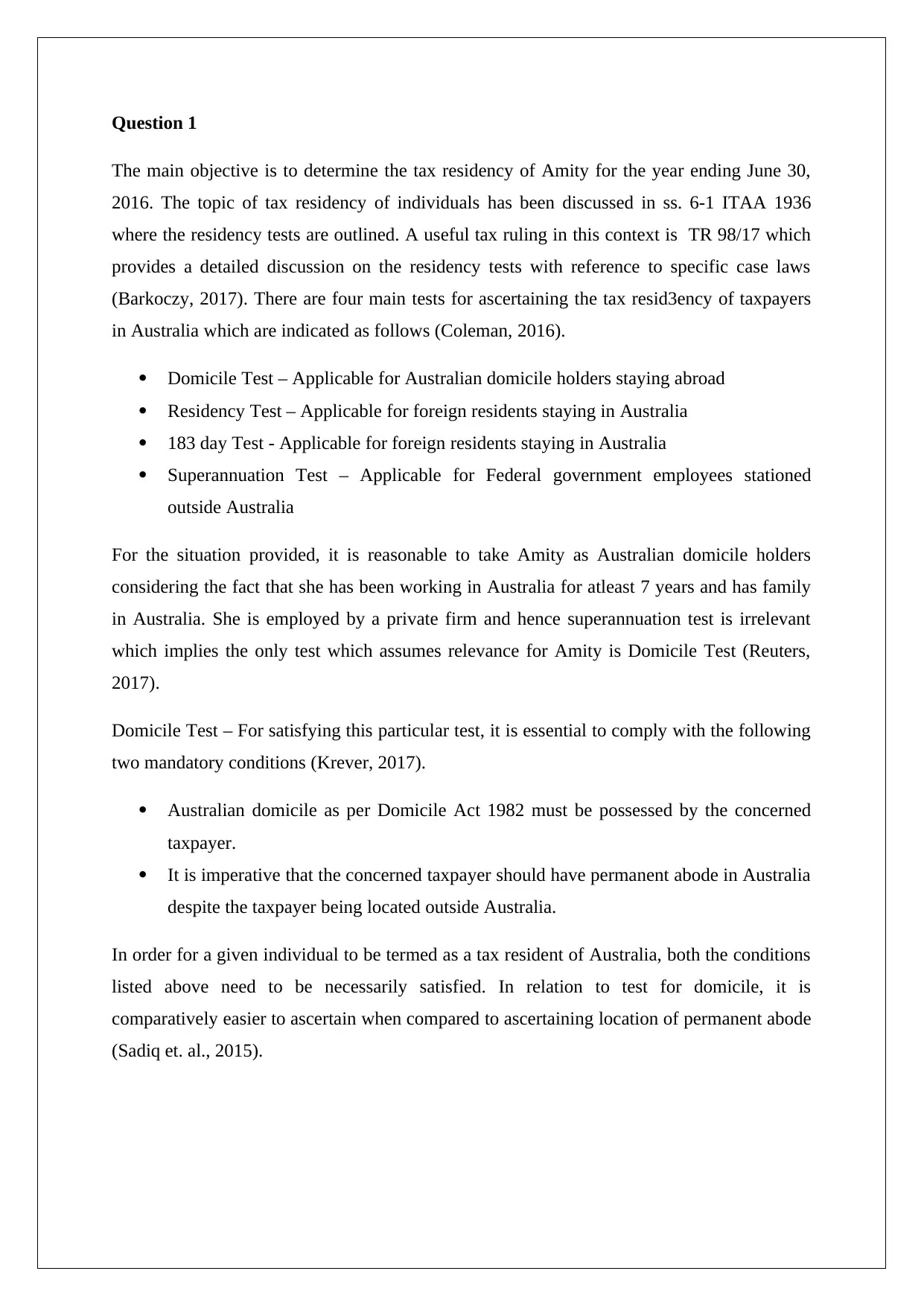
Question 1
The main objective is to determine the tax residency of Amity for the year ending June 30,
2016. The topic of tax residency of individuals has been discussed in ss. 6-1 ITAA 1936
where the residency tests are outlined. A useful tax ruling in this context is TR 98/17 which
provides a detailed discussion on the residency tests with reference to specific case laws
(Barkoczy, 2017). There are four main tests for ascertaining the tax resid3ency of taxpayers
in Australia which are indicated as follows (Coleman, 2016).
Domicile Test – Applicable for Australian domicile holders staying abroad
Residency Test – Applicable for foreign residents staying in Australia
183 day Test - Applicable for foreign residents staying in Australia
Superannuation Test – Applicable for Federal government employees stationed
outside Australia
For the situation provided, it is reasonable to take Amity as Australian domicile holders
considering the fact that she has been working in Australia for atleast 7 years and has family
in Australia. She is employed by a private firm and hence superannuation test is irrelevant
which implies the only test which assumes relevance for Amity is Domicile Test (Reuters,
2017).
Domicile Test – For satisfying this particular test, it is essential to comply with the following
two mandatory conditions (Krever, 2017).
Australian domicile as per Domicile Act 1982 must be possessed by the concerned
taxpayer.
It is imperative that the concerned taxpayer should have permanent abode in Australia
despite the taxpayer being located outside Australia.
In order for a given individual to be termed as a tax resident of Australia, both the conditions
listed above need to be necessarily satisfied. In relation to test for domicile, it is
comparatively easier to ascertain when compared to ascertaining location of permanent abode
(Sadiq et. al., 2015).
The main objective is to determine the tax residency of Amity for the year ending June 30,
2016. The topic of tax residency of individuals has been discussed in ss. 6-1 ITAA 1936
where the residency tests are outlined. A useful tax ruling in this context is TR 98/17 which
provides a detailed discussion on the residency tests with reference to specific case laws
(Barkoczy, 2017). There are four main tests for ascertaining the tax resid3ency of taxpayers
in Australia which are indicated as follows (Coleman, 2016).
Domicile Test – Applicable for Australian domicile holders staying abroad
Residency Test – Applicable for foreign residents staying in Australia
183 day Test - Applicable for foreign residents staying in Australia
Superannuation Test – Applicable for Federal government employees stationed
outside Australia
For the situation provided, it is reasonable to take Amity as Australian domicile holders
considering the fact that she has been working in Australia for atleast 7 years and has family
in Australia. She is employed by a private firm and hence superannuation test is irrelevant
which implies the only test which assumes relevance for Amity is Domicile Test (Reuters,
2017).
Domicile Test – For satisfying this particular test, it is essential to comply with the following
two mandatory conditions (Krever, 2017).
Australian domicile as per Domicile Act 1982 must be possessed by the concerned
taxpayer.
It is imperative that the concerned taxpayer should have permanent abode in Australia
despite the taxpayer being located outside Australia.
In order for a given individual to be termed as a tax resident of Australia, both the conditions
listed above need to be necessarily satisfied. In relation to test for domicile, it is
comparatively easier to ascertain when compared to ascertaining location of permanent abode
(Sadiq et. al., 2015).

A case law which merits discussion is F.C. of T. v. Applegate (1979) 9 ATR 899. As per this
case, an Australian company sent the taxpayer (who was Australian resident) to set up an
office abroad. Considering the nature of the task, the time frame was not clear but it was
apparent that it would be significant. However, it was clear from the starting that as soon as
the foreign branch is established the taxpayer would return to Australia. The taxpayer fell
severely ill and had to permanently return to Australia after two years even though the work
was not finished. The court decided that moving away from Australia for substantial period
does conduct shifting of permanent abode abroad and hence held the taxpayer as a foreign tax
resident (Barkoczy, 2017). Another comparable case is F.C. of T. v. Jenkins (1982) 12 ATR
745 in which also the taxpayer was declared as a foreign tax resident. In this case also, a tax
payer was sent abroad for a period of three years for professional purposes but owing to
illness had to come back to Australia within 2 years (Deutsch, Freizer, Fullerton, Hanley &
Snape, 2015).
Taking the case laws discussed above under consideration, it can be concluded that case face
of the Amity are similar to those listed above since she has been relocated to Karabati for
atleast 2 years which can be further extended by three years. Amity has developed substantial
ties with Kiribati as she has relocated with her family (husband) and has also initially bought
a house besides opening a bank account. Thus, based on the discussion above and the
relevant case facts, it is appropriate to conclude that Amity for the tax year 2015/2016 would
be categorised as a foreign tax resident.
Question 2
a) In accordance with the scenario presented, a transaction involving barter has been enacted
between the client and dentist. A case worth discussion is F.C. of T. v. Cooke & Sherden 80
ATC 4140 as it indicates that if any consideration as a result of barter would be categorised
as income in accordance with s. 25-1 ITAA 1936, then the transaction related consideration
derived by the taxpayer would also be income in nature and attract tax (Reuters, 2017). Also,
Henderson v FCT 70 ATC 4016 highlights that in case of professional services being
extended to client, once services have been provided, a receivable arises, the settlement of
which leads to assessable income (Krever, 2017). Taking into cognizance the cases
highlighted above, it is correct to conclude that the dentist would realise an income of $ 550
since the toy received has a market value of $ 550.
case, an Australian company sent the taxpayer (who was Australian resident) to set up an
office abroad. Considering the nature of the task, the time frame was not clear but it was
apparent that it would be significant. However, it was clear from the starting that as soon as
the foreign branch is established the taxpayer would return to Australia. The taxpayer fell
severely ill and had to permanently return to Australia after two years even though the work
was not finished. The court decided that moving away from Australia for substantial period
does conduct shifting of permanent abode abroad and hence held the taxpayer as a foreign tax
resident (Barkoczy, 2017). Another comparable case is F.C. of T. v. Jenkins (1982) 12 ATR
745 in which also the taxpayer was declared as a foreign tax resident. In this case also, a tax
payer was sent abroad for a period of three years for professional purposes but owing to
illness had to come back to Australia within 2 years (Deutsch, Freizer, Fullerton, Hanley &
Snape, 2015).
Taking the case laws discussed above under consideration, it can be concluded that case face
of the Amity are similar to those listed above since she has been relocated to Karabati for
atleast 2 years which can be further extended by three years. Amity has developed substantial
ties with Kiribati as she has relocated with her family (husband) and has also initially bought
a house besides opening a bank account. Thus, based on the discussion above and the
relevant case facts, it is appropriate to conclude that Amity for the tax year 2015/2016 would
be categorised as a foreign tax resident.
Question 2
a) In accordance with the scenario presented, a transaction involving barter has been enacted
between the client and dentist. A case worth discussion is F.C. of T. v. Cooke & Sherden 80
ATC 4140 as it indicates that if any consideration as a result of barter would be categorised
as income in accordance with s. 25-1 ITAA 1936, then the transaction related consideration
derived by the taxpayer would also be income in nature and attract tax (Reuters, 2017). Also,
Henderson v FCT 70 ATC 4016 highlights that in case of professional services being
extended to client, once services have been provided, a receivable arises, the settlement of
which leads to assessable income (Krever, 2017). Taking into cognizance the cases
highlighted above, it is correct to conclude that the dentist would realise an income of $ 550
since the toy received has a market value of $ 550.
⊘ This is a preview!⊘
Do you want full access?
Subscribe today to unlock all pages.

Trusted by 1+ million students worldwide
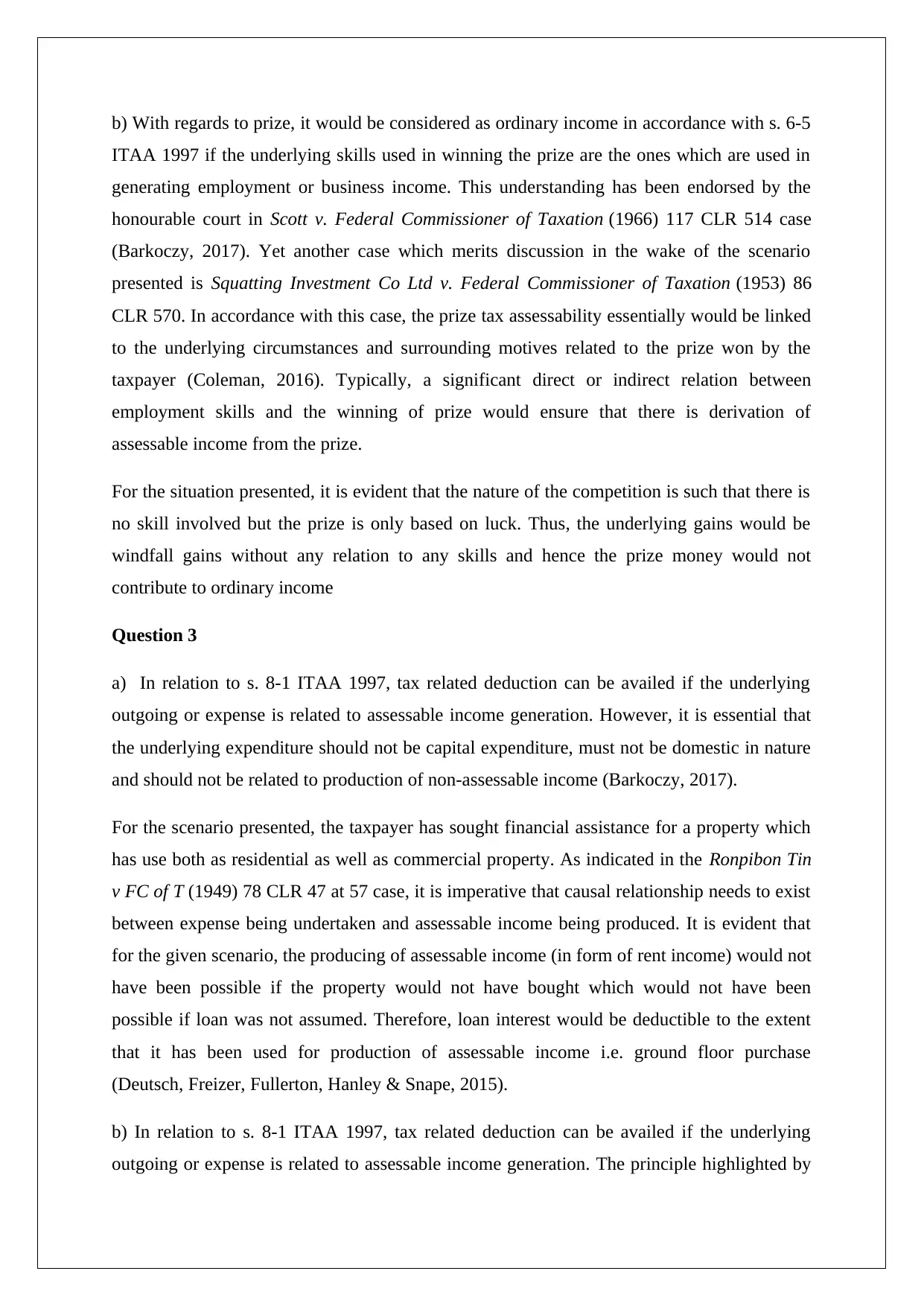
b) With regards to prize, it would be considered as ordinary income in accordance with s. 6-5
ITAA 1997 if the underlying skills used in winning the prize are the ones which are used in
generating employment or business income. This understanding has been endorsed by the
honourable court in Scott v. Federal Commissioner of Taxation (1966) 117 CLR 514 case
(Barkoczy, 2017). Yet another case which merits discussion in the wake of the scenario
presented is Squatting Investment Co Ltd v. Federal Commissioner of Taxation (1953) 86
CLR 570. In accordance with this case, the prize tax assessability essentially would be linked
to the underlying circumstances and surrounding motives related to the prize won by the
taxpayer (Coleman, 2016). Typically, a significant direct or indirect relation between
employment skills and the winning of prize would ensure that there is derivation of
assessable income from the prize.
For the situation presented, it is evident that the nature of the competition is such that there is
no skill involved but the prize is only based on luck. Thus, the underlying gains would be
windfall gains without any relation to any skills and hence the prize money would not
contribute to ordinary income
Question 3
a) In relation to s. 8-1 ITAA 1997, tax related deduction can be availed if the underlying
outgoing or expense is related to assessable income generation. However, it is essential that
the underlying expenditure should not be capital expenditure, must not be domestic in nature
and should not be related to production of non-assessable income (Barkoczy, 2017).
For the scenario presented, the taxpayer has sought financial assistance for a property which
has use both as residential as well as commercial property. As indicated in the Ronpibon Tin
v FC of T (1949) 78 CLR 47 at 57 case, it is imperative that causal relationship needs to exist
between expense being undertaken and assessable income being produced. It is evident that
for the given scenario, the producing of assessable income (in form of rent income) would not
have been possible if the property would not have bought which would not have been
possible if loan was not assumed. Therefore, loan interest would be deductible to the extent
that it has been used for production of assessable income i.e. ground floor purchase
(Deutsch, Freizer, Fullerton, Hanley & Snape, 2015).
b) In relation to s. 8-1 ITAA 1997, tax related deduction can be availed if the underlying
outgoing or expense is related to assessable income generation. The principle highlighted by
ITAA 1997 if the underlying skills used in winning the prize are the ones which are used in
generating employment or business income. This understanding has been endorsed by the
honourable court in Scott v. Federal Commissioner of Taxation (1966) 117 CLR 514 case
(Barkoczy, 2017). Yet another case which merits discussion in the wake of the scenario
presented is Squatting Investment Co Ltd v. Federal Commissioner of Taxation (1953) 86
CLR 570. In accordance with this case, the prize tax assessability essentially would be linked
to the underlying circumstances and surrounding motives related to the prize won by the
taxpayer (Coleman, 2016). Typically, a significant direct or indirect relation between
employment skills and the winning of prize would ensure that there is derivation of
assessable income from the prize.
For the situation presented, it is evident that the nature of the competition is such that there is
no skill involved but the prize is only based on luck. Thus, the underlying gains would be
windfall gains without any relation to any skills and hence the prize money would not
contribute to ordinary income
Question 3
a) In relation to s. 8-1 ITAA 1997, tax related deduction can be availed if the underlying
outgoing or expense is related to assessable income generation. However, it is essential that
the underlying expenditure should not be capital expenditure, must not be domestic in nature
and should not be related to production of non-assessable income (Barkoczy, 2017).
For the scenario presented, the taxpayer has sought financial assistance for a property which
has use both as residential as well as commercial property. As indicated in the Ronpibon Tin
v FC of T (1949) 78 CLR 47 at 57 case, it is imperative that causal relationship needs to exist
between expense being undertaken and assessable income being produced. It is evident that
for the given scenario, the producing of assessable income (in form of rent income) would not
have been possible if the property would not have bought which would not have been
possible if loan was not assumed. Therefore, loan interest would be deductible to the extent
that it has been used for production of assessable income i.e. ground floor purchase
(Deutsch, Freizer, Fullerton, Hanley & Snape, 2015).
b) In relation to s. 8-1 ITAA 1997, tax related deduction can be availed if the underlying
outgoing or expense is related to assessable income generation. The principle highlighted by
Paraphrase This Document
Need a fresh take? Get an instant paraphrase of this document with our AI Paraphraser
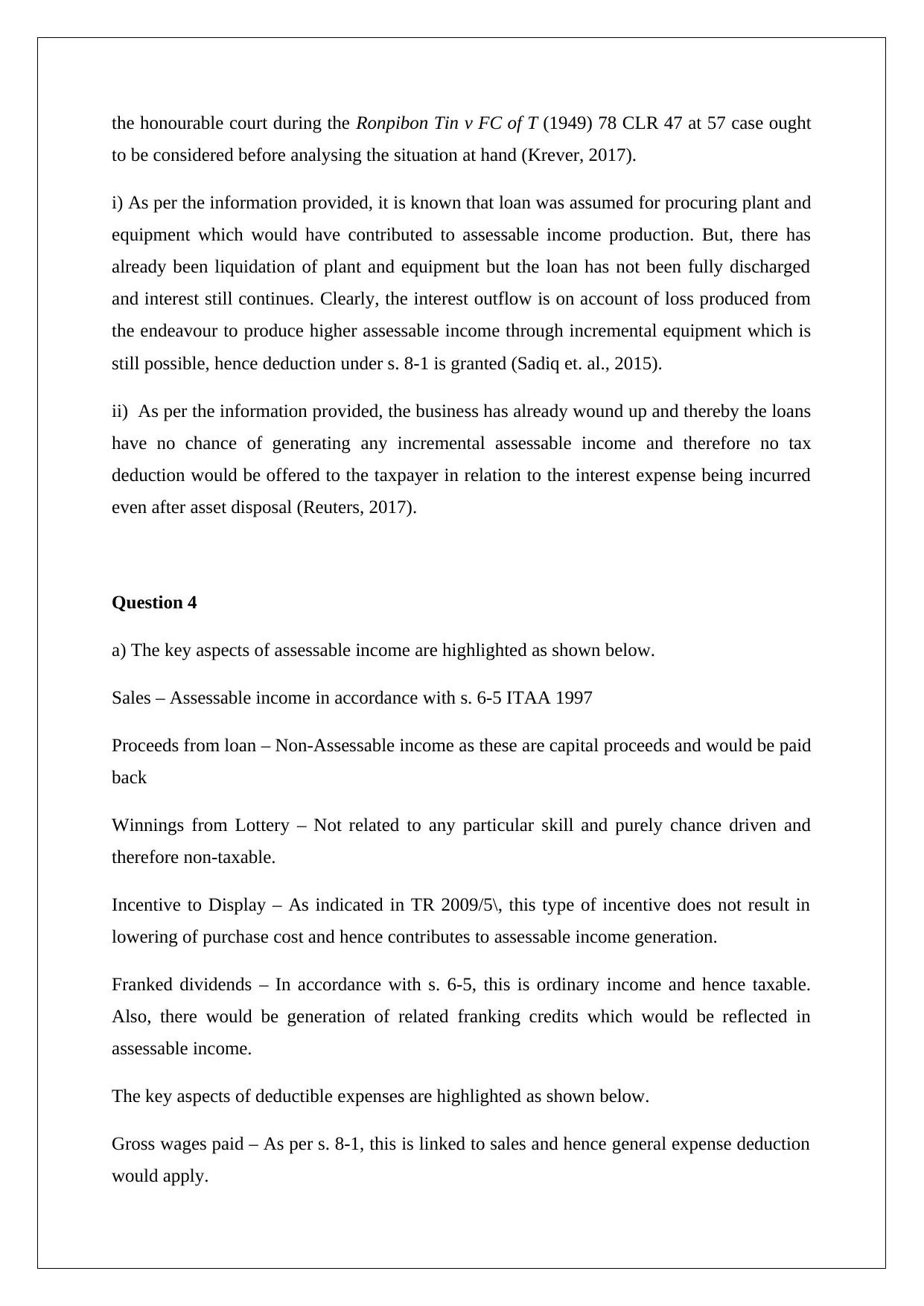
the honourable court during the Ronpibon Tin v FC of T (1949) 78 CLR 47 at 57 case ought
to be considered before analysing the situation at hand (Krever, 2017).
i) As per the information provided, it is known that loan was assumed for procuring plant and
equipment which would have contributed to assessable income production. But, there has
already been liquidation of plant and equipment but the loan has not been fully discharged
and interest still continues. Clearly, the interest outflow is on account of loss produced from
the endeavour to produce higher assessable income through incremental equipment which is
still possible, hence deduction under s. 8-1 is granted (Sadiq et. al., 2015).
ii) As per the information provided, the business has already wound up and thereby the loans
have no chance of generating any incremental assessable income and therefore no tax
deduction would be offered to the taxpayer in relation to the interest expense being incurred
even after asset disposal (Reuters, 2017).
Question 4
a) The key aspects of assessable income are highlighted as shown below.
Sales – Assessable income in accordance with s. 6-5 ITAA 1997
Proceeds from loan – Non-Assessable income as these are capital proceeds and would be paid
back
Winnings from Lottery – Not related to any particular skill and purely chance driven and
therefore non-taxable.
Incentive to Display – As indicated in TR 2009/5\, this type of incentive does not result in
lowering of purchase cost and hence contributes to assessable income generation.
Franked dividends – In accordance with s. 6-5, this is ordinary income and hence taxable.
Also, there would be generation of related franking credits which would be reflected in
assessable income.
The key aspects of deductible expenses are highlighted as shown below.
Gross wages paid – As per s. 8-1, this is linked to sales and hence general expense deduction
would apply.
to be considered before analysing the situation at hand (Krever, 2017).
i) As per the information provided, it is known that loan was assumed for procuring plant and
equipment which would have contributed to assessable income production. But, there has
already been liquidation of plant and equipment but the loan has not been fully discharged
and interest still continues. Clearly, the interest outflow is on account of loss produced from
the endeavour to produce higher assessable income through incremental equipment which is
still possible, hence deduction under s. 8-1 is granted (Sadiq et. al., 2015).
ii) As per the information provided, the business has already wound up and thereby the loans
have no chance of generating any incremental assessable income and therefore no tax
deduction would be offered to the taxpayer in relation to the interest expense being incurred
even after asset disposal (Reuters, 2017).
Question 4
a) The key aspects of assessable income are highlighted as shown below.
Sales – Assessable income in accordance with s. 6-5 ITAA 1997
Proceeds from loan – Non-Assessable income as these are capital proceeds and would be paid
back
Winnings from Lottery – Not related to any particular skill and purely chance driven and
therefore non-taxable.
Incentive to Display – As indicated in TR 2009/5\, this type of incentive does not result in
lowering of purchase cost and hence contributes to assessable income generation.
Franked dividends – In accordance with s. 6-5, this is ordinary income and hence taxable.
Also, there would be generation of related franking credits which would be reflected in
assessable income.
The key aspects of deductible expenses are highlighted as shown below.
Gross wages paid – As per s. 8-1, this is linked to sales and hence general expense deduction
would apply.
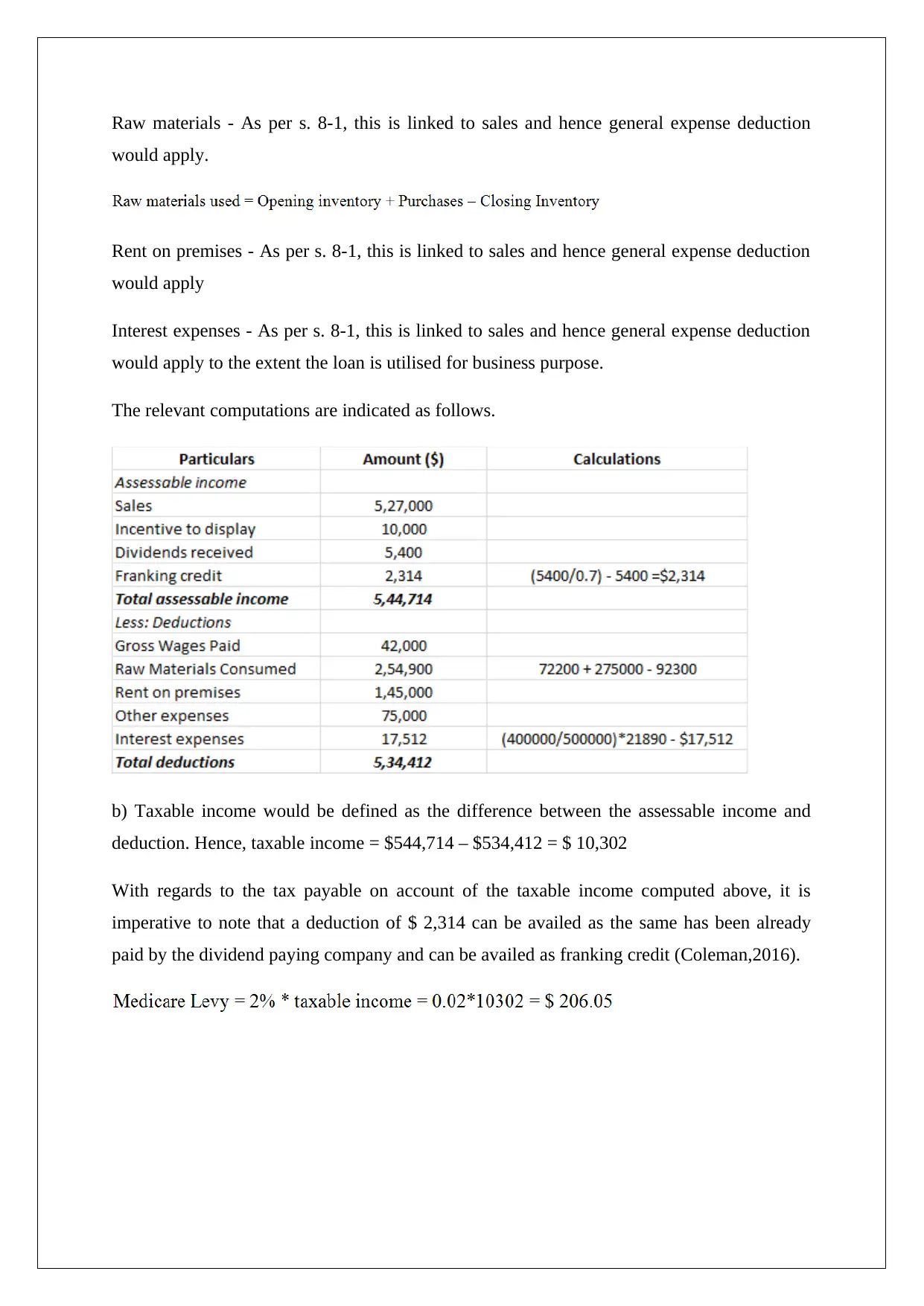
Raw materials - As per s. 8-1, this is linked to sales and hence general expense deduction
would apply.
Rent on premises - As per s. 8-1, this is linked to sales and hence general expense deduction
would apply
Interest expenses - As per s. 8-1, this is linked to sales and hence general expense deduction
would apply to the extent the loan is utilised for business purpose.
The relevant computations are indicated as follows.
b) Taxable income would be defined as the difference between the assessable income and
deduction. Hence, taxable income = $544,714 – $534,412 = $ 10,302
With regards to the tax payable on account of the taxable income computed above, it is
imperative to note that a deduction of $ 2,314 can be availed as the same has been already
paid by the dividend paying company and can be availed as franking credit (Coleman,2016).
would apply.
Rent on premises - As per s. 8-1, this is linked to sales and hence general expense deduction
would apply
Interest expenses - As per s. 8-1, this is linked to sales and hence general expense deduction
would apply to the extent the loan is utilised for business purpose.
The relevant computations are indicated as follows.
b) Taxable income would be defined as the difference between the assessable income and
deduction. Hence, taxable income = $544,714 – $534,412 = $ 10,302
With regards to the tax payable on account of the taxable income computed above, it is
imperative to note that a deduction of $ 2,314 can be availed as the same has been already
paid by the dividend paying company and can be availed as franking credit (Coleman,2016).
⊘ This is a preview!⊘
Do you want full access?
Subscribe today to unlock all pages.

Trusted by 1+ million students worldwide
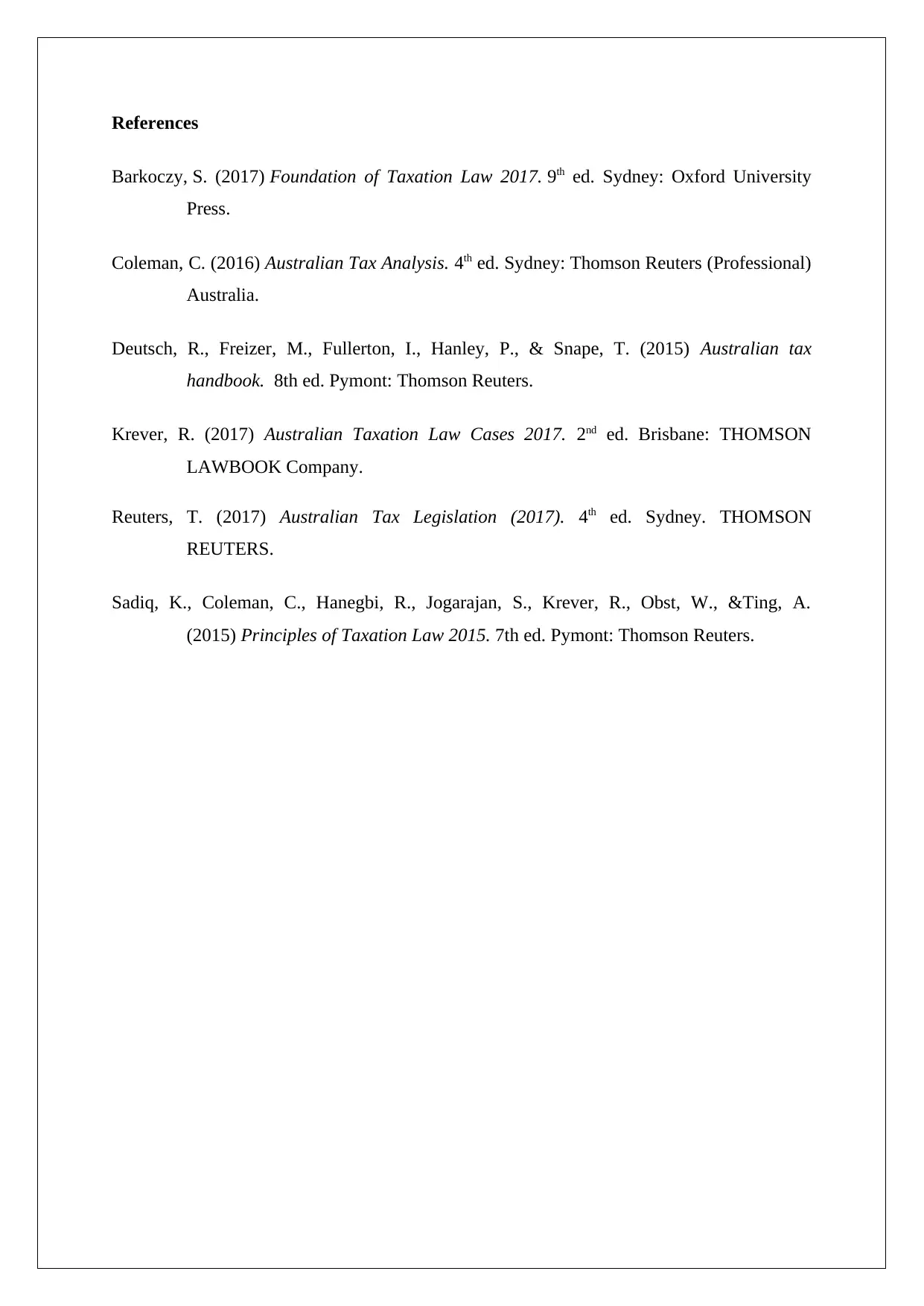
References
Barkoczy, S. (2017) Foundation of Taxation Law 2017. 9th ed. Sydney: Oxford University
Press.
Coleman, C. (2016) Australian Tax Analysis. 4th ed. Sydney: Thomson Reuters (Professional)
Australia.
Deutsch, R., Freizer, M., Fullerton, I., Hanley, P., & Snape, T. (2015) Australian tax
handbook. 8th ed. Pymont: Thomson Reuters.
Krever, R. (2017) Australian Taxation Law Cases 2017. 2nd ed. Brisbane: THOMSON
LAWBOOK Company.
Reuters, T. (2017) Australian Tax Legislation (2017). 4th ed. Sydney. THOMSON
REUTERS.
Sadiq, K., Coleman, C., Hanegbi, R., Jogarajan, S., Krever, R., Obst, W., &Ting, A.
(2015) Principles of Taxation Law 2015. 7th ed. Pymont: Thomson Reuters.
Barkoczy, S. (2017) Foundation of Taxation Law 2017. 9th ed. Sydney: Oxford University
Press.
Coleman, C. (2016) Australian Tax Analysis. 4th ed. Sydney: Thomson Reuters (Professional)
Australia.
Deutsch, R., Freizer, M., Fullerton, I., Hanley, P., & Snape, T. (2015) Australian tax
handbook. 8th ed. Pymont: Thomson Reuters.
Krever, R. (2017) Australian Taxation Law Cases 2017. 2nd ed. Brisbane: THOMSON
LAWBOOK Company.
Reuters, T. (2017) Australian Tax Legislation (2017). 4th ed. Sydney. THOMSON
REUTERS.
Sadiq, K., Coleman, C., Hanegbi, R., Jogarajan, S., Krever, R., Obst, W., &Ting, A.
(2015) Principles of Taxation Law 2015. 7th ed. Pymont: Thomson Reuters.
1 out of 7
Related Documents
Your All-in-One AI-Powered Toolkit for Academic Success.
+13062052269
info@desklib.com
Available 24*7 on WhatsApp / Email
![[object Object]](/_next/static/media/star-bottom.7253800d.svg)
Unlock your academic potential
© 2024 | Zucol Services PVT LTD | All rights reserved.





